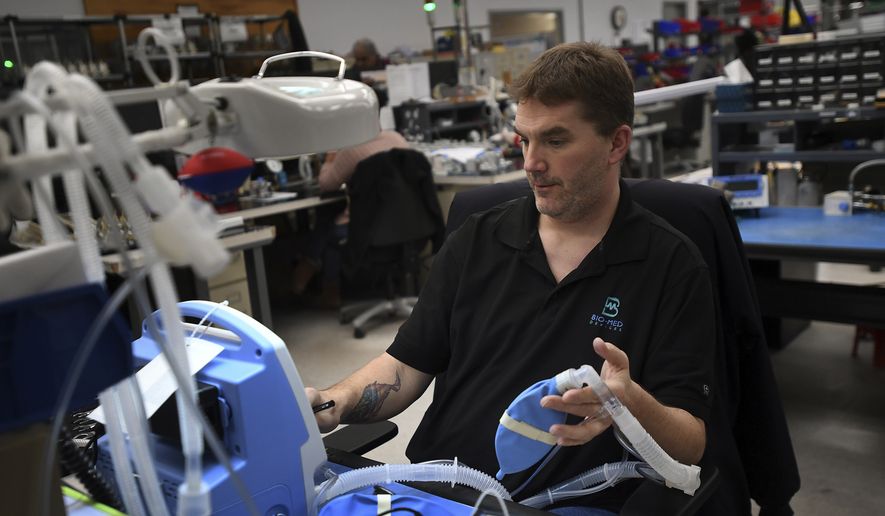The federal government announced Wednesday it has 10,469 ventilators in reserve, ready to dole out to needy states amid the coronavirus crisis. Now it will make what could be literally life-and-death decisions about where they’ll go.
Acknowledging a “scarcity,” the Federal Emergency Management Agency said states and tribal governments will have to prove an immediate need — “defined as requirements necessary to sustain life within a 72-hour window,” FEMA said — and will have to divulge key details about their equipment stockpiles and hospital beds.
The agency said it already has earmarked 400 of the machines for Michigan, 300 for New Jersey, 150 each for Louisiana and Illinois, and 50 for Connecticut. Those deliveries should be complete by Thursday.
At the White House, President Trump said federal officials are working on other locations.
“As this scourge, as this plague, as this virus moves, it moves very fast and we don’t know yet whether we are going to need it in Louisiana or New York or wherever it is going to be,” he said. “We have to have the flexibility of moving the ventilators to where the virus is going. And we will be able to see that from charts a couple of days in advance.”
Shut-down orders and social distancing are the front-end solutions to COVID-19, intended to limit infections. But there is no cure for those infected, and the worst cases cause severe respiratory struggles. That’s where ventilators come in, breathing for the patient and hopefully buying time for a recovery.
FEMA said there are 9,404 ventilators in the Strategic National Stockpile, a cache maintained by the Health Department, and another 1,065 held by the Defense Department.
Dr. Anand Parekh, a former deputy assistant secretary at the Health Department, said it’s good to know that number, but we still don’t know the “gap analysis” — how many ventilators are held in each state, and how many will be needed.
“Without that transparent analysis, it’s difficult to know how to triage ventilators which are in short supply,” he said. “I understand that each state is being asked to provide daily inventory to the federal government to better assess current capacity. This all needs to come together very quickly as you can imagine.”
Dr. Parekh, who is now chief medical advisor at the Bipartisan Policy Center, said the federal government is likely to deploy some of its stockpile to hotspots while holding back other ventilators for the next wave of cases in other locations.
The feds have already sent thousands of ventilators to hotspots.
California said Los Angeles got 170 ventilators last week — but they were broken. Gov. Gavin Newsom said that rather than complain, his state shipped the ventilators to a shop for immediate repairs, to have them up and working this week.
The ventilator shortage has left some critics wondering why there isn’t a bigger stockpile.
Before the coronavirus crisis, the demand was about 2,000 to 3,000 a week — which was supplied by fewer than a dozen manufacturers. With demand soaring, the companies have added third shifts and gone to 24/7 production, and hope to be at 15,000 a week by the end of this month.
Now the industry has to grapple with how to allocate them.
“During the normal course of events, we would fill orders as they came in and distribute accordingly. But this is not a normal time, so we’ve been working with FEMA and the federal government to come up with an allocation system that makes sense given the scale of the public health crisis we are facing,” said Scott Whitaker, president of the Advanced Medical Technology Association.
Researchers and inventors have rushed to their workbenches, looking to come up with kludge solutions to the ventilator shortage.
In Massachusetts, faculty and students at Worcester Polytechnic Institute launched an effort to come up with ways to automate Bag-Valve-Mask breathers, which usually require a person to squeeze the bag.
Auto manufacturers said they were already rushing to convert product lines to produce ventilators even before President Trump last week invoked the Defense Production Act to force General Motors to do so. By Sunday, Mr. Trump was praising the company’s efforts.
Last week, New York approved the sharing of ventilators, allowing two patients to be hooked up to the same machine. The federal government gave its OK to the practice this week.
While all of those are being tried, Dr. Parekh said the existing ventilators are key.
“We need to optimize the current supply chain and ensure there is proper resource allocation so that they get to the right places at the right time. The Defense Logistics Agency could be very helpful here,” he said.
New York says it might need 30,000 ventilators just by itself, based on the numbers there.
But experts have no clear idea of national needs.
Dr. James Lawler, an infectious disease specialist at the University of Nebraska Medical Center, predicted in February that the U.S. could reach 96 million cases of COVID-19 infection, with 1% of those patients needing a ventilator at some point. That’d be nearly 1 million people, close to 100 times the federal government’s current stockpile.
Other experts caution that understanding of the disease is evolving quickly.
It’s also not clear what the success rate is for ventilators.
A doctor who blogs at Physician’s Weekly under the name Skeptical Scalpel asked hospital employees to weigh in on what they’re seeing in mortality rates. He got back estimates ranging from 25% to 70%
Skeptical Scalpel wrote that doctors need a better sense for that figure to know how to approach life-and-death decisions as the crisis worsens
“The possible need for ventilator triage is no longer theoretical, and the ethical issues are being discussed by hospital committees and others,” he wrote.
• Stephen Dinan can be reached at sdinan@washingtontimes.com.
• S.A. Miller can be reached at smiller@washingtontimes.com.




Please read our comment policy before commenting.